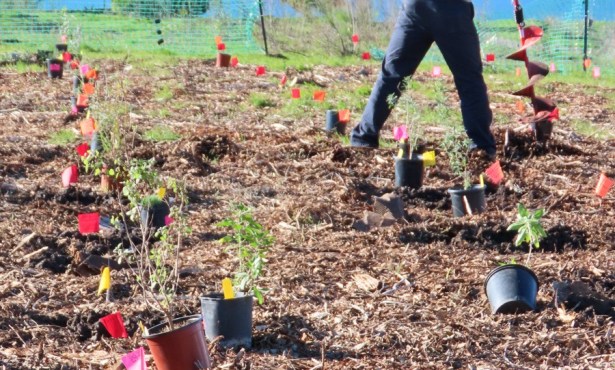Manzana Free Camp
Ambling Along a Green Stream Between Glowering Hot Hillsides
Name of hike: Manzana ‘free camp’ backpack
Mileage: ca. 18 mile moderate roundtrip (most of it along pristine Manzana Creek)
Suggested time: 3 days; very pleasant for hardy kids over 9
Map: B. Conant’s San Rafael Wilderness Trail Map Guide
When Jim Holt asks the crucial question “Why is there something instead of nothing?” in his new book Why Does the World Exist?, I wonder why there aren’t more three-day/two-night weekends for backpacking?

In teaching middle-school age students in Santa Barbara for three decades, I haven’t had too many opportunities to go beyond the two-day/one-night backpack model. It’s too tough to embark on a two-day backpack like the one I made in February of 2012 — that was 17.2 miles with just one freezing overnight at Manzana Schoolhouse.
However, various holiday Mondays present persistent packers with a few three-day weekends, including Martin Luther King, Jr. Day, President’s Day, and Memorial Day. Therefore, one subseries of my recurring forays into the San Rafael Wilderness wraps itself around the strenuous three-day/two-night model.
The Manzana backpacking venture described below works very well on this 3/2 template, and since the trailhead at Nira Camp is just 47 miles from my little house on Santa Barbara’s Westside, it’s pretty basic to leap into the truck and drive there.
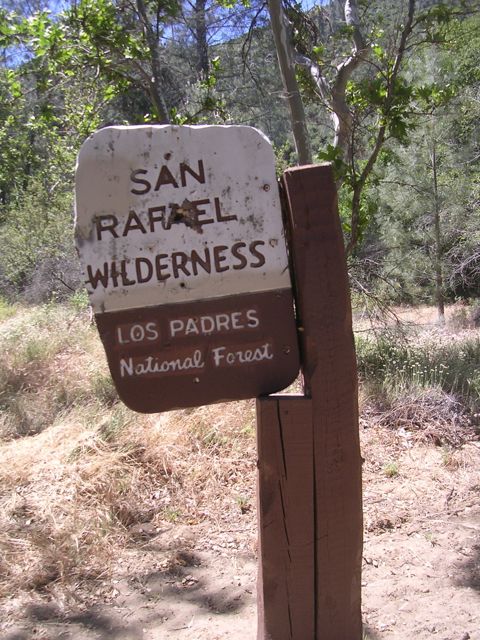
Day One of the “3/2” begins with deliberately leaving civilization behind. Crazed from many wonderful hours, weeks, and months in the classroom, the aging neophyte rushes into the pristine nature of the fabled San Rafael Wilderness (“San Raf”), east of Santa Barbara town. I roar out of the grody Westside pondering the mystery of existence while jumping onto the 101 North and driving over Highway 154 past Lake Cachuma, and onto Happy Canyon Road until it ends, at Nira Camp, arriving at 6 a.m. Once I’ve strapped on the 28 lb. backpack, I’m marching off very early along the northern bank of meandering Manzana Creek. [PHOTO 2]
At school, I’m surrounded by scores of amazing children. During these teaching periods I try to give maximum focus and care to my students. I never eat lunch in the faculty kitchen or in my room, preferring to sit with students at the outdoor lunch tables. My spouse contends I’ve managed to retain some of the “emotional tone of childhood” Carl Jung felt was essential to mental health and creativity, through spending the last 33 years with children. Therefore, I saunter off into the San Raf with childlike glee and full expectation of a peak experience.
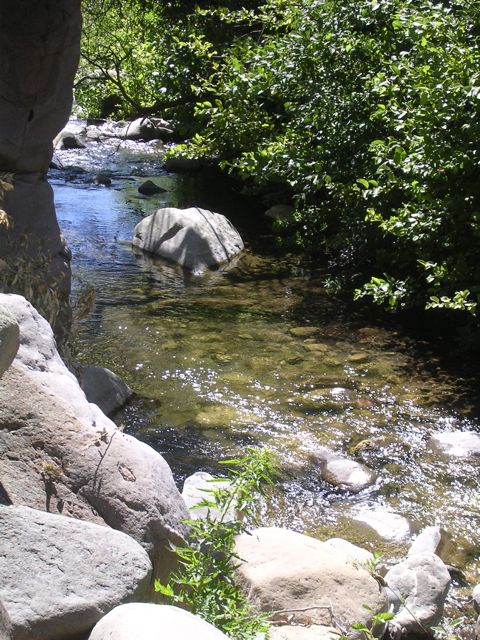
Absolutely as excited as the first time I backpacked up the Manzana in 1973, I dance across the creek crossing at Nira and skip into the San Raf filled with wonderment as the white noise recedes, fragrant smells intensify, the Western linear time-sense dims, and the shadow self embraces this shining other world. Physicist Brian Greene easily accepts the notion of parallel and alternate universes – it’s certainly another realm here. I’m very attentive, yet not rushed. I’m immersed in signs, smells, sights, emotions, and the water-music emanating from the softly rushing stream alongside my path.
Holt is hardly the first to wrestle with the universal query (think of John Paul Being and Nothingness Sartre), but he manages to reinvigorate the discussion. He follows the salutary debate kicked off by Richard (The God Delusion) Dawkins and the late Christopher Hitchens, which Holt calls the “God wars.” Dawkins and Hitchens (who called himself an “antitheist” rather than an atheist) led a postmodern assault on Fortress Deity. (And when we remember the sick, criminal acts of priests right there in Santa Barbara, it’s easy to understand the appeal of atheism based on hatred of the church hierarchy.) Yet neither Dawkins nor Hitchens (nor Sam The End of Faith Harris) can begin to answer the meta-scientific question of our time: Why is there something instead of nothing?
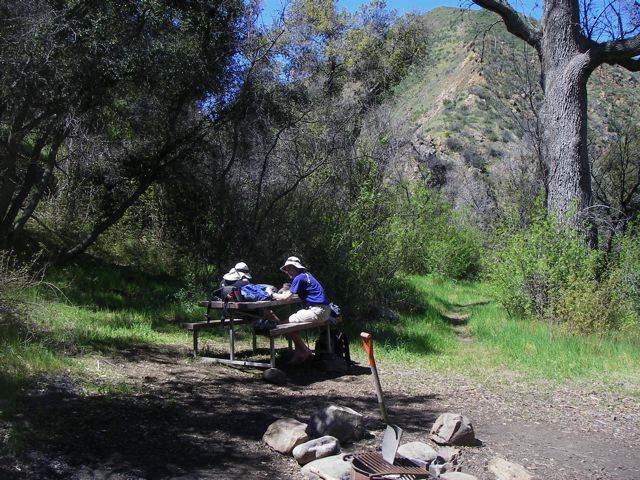
Sure, there’s the big bang, in which the known universe exploded and began expanding — but when (13.7 billion years ago) doesn’t mean you know how or why the ‘big’ initially ‘banged.’ What force ignited the big bang, and what was the fuel? Modern science can ask the question about the beginning of the universe, but its limited horizon doesn’t begin to possess the instruments able to peek over that plane of reality. Scientists have their own concealed ‘religious’ presuppositions: They have to assume some sort of original cosmic egg or tiny bit of quantum vacuum, Heisenberg’s uncertainty principle, or perhaps the weird bosons acting up. Nevertheless, it’s easy for Dawkins et al to ridicule intelligent design and the Adam and Eve creation myth.
We can rant and debate forever. The “second-hand thinking” so derided by Krishnamurti and George Orwell, afflicts most of us. It’s too easy to rehearse a few of its causes (none of which can be found along Manzana Creek): long work hours, crowded schedules, too much screen time, smart-phone madness, constant war, wretched American films. Add incessant angst, insomnia, bad food, gun violence, concealed class warfare, rage, and so on – and then we have to try to answer why: Why was a man shot on Olive Street, why was a man stabbed to death on West Valerio Street, why did a hunter so casually and callously kill Billy the dog near 19 Oaks Camp? An example of the paralysis of analysis is the intense line of comments, almost 200 of them, under the seemingly innocuous Santa Barbara Independent article titled “Affordable Housing’s Prospects.” Those thread wars can be fascinating, but they often end up in tautologies wherein most of the contributors stay in their own loop. I’ve certainly embodied this inability to change on the thread.
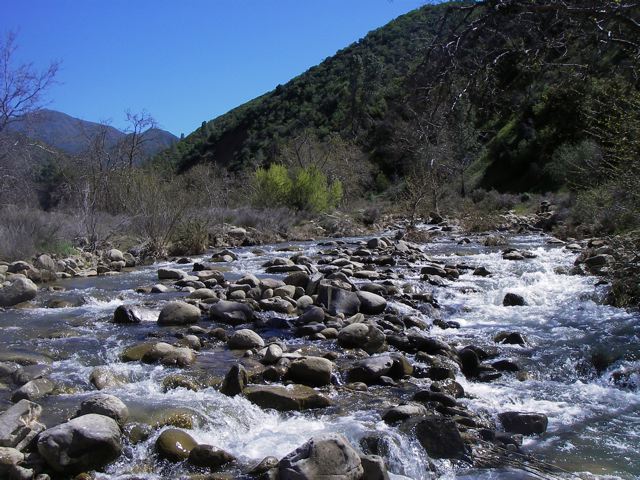
Learning new natural worlds and changing your thinking: This leads me right onto the Manzana Creek Trail. In the modern West there is the constant imperative to understand, but I feel a constant imperative to rush out to one of our five local wilderness zones. My Ford Ranger truck is always half-packed and the backpack hangs up in the garage, ready to go at an hour’s notice. “Why does the world exist?” pales next to full immersion in those precious raw-nature portions that stretch your senses in such a way that the over-thinking palls and finally disappears.
Hiking for one mile, the backpacker reaches lovely Lost Valley Camp, but it’s too close to Nira and often packed with cool-school groups from Dunn or Midland, or with Boy Scouts. The writer plods on, floating amid the greenery of ripe riparian woodland and soft chaparral flora, sharing the environment with plenty of micro-fauna like ants and flying insects, water beetles and toe-biters, and lizards galore.
The Manzana Creek itself flows for only 16 miles, winding sinuously between rising dry hillsides festooned with yucca, manzanita, ceanothus, and myriad other hard chaparral flora. It’s tremendously antipodal terrain: the sere and sunbaked, rocky hillsides, and between them the stream, where I mostly walk, with its soft moist plants, its shady bay trees, willows, and sycamores.
It would be difficult to go off-trail on this 3-day/2-night backpack: You’re almost always in view of the Manzana itself, if not right next to it as you walk. Plan to cross and recross the waterway several times.
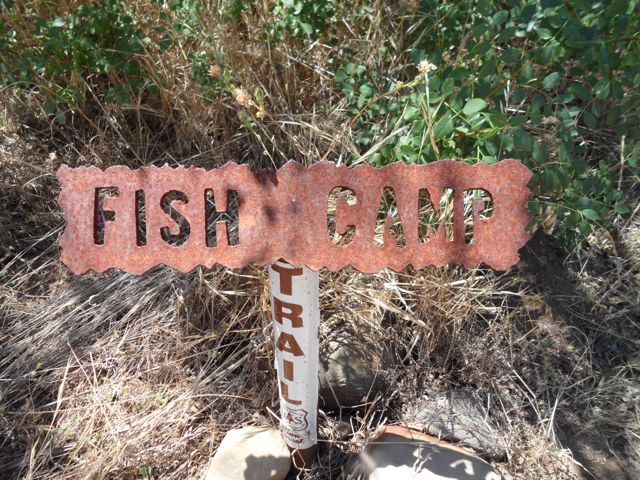
After Lost Valley Camp the writer knocks out two fairly easy miles, almost all of it on the north [left] side of the creek, and drops into signed Fish Camp, on the south side of the creek, for a break. There are two tables and a nice big firepit; this is also a Boy Scout favorite so I seldom overnight here.
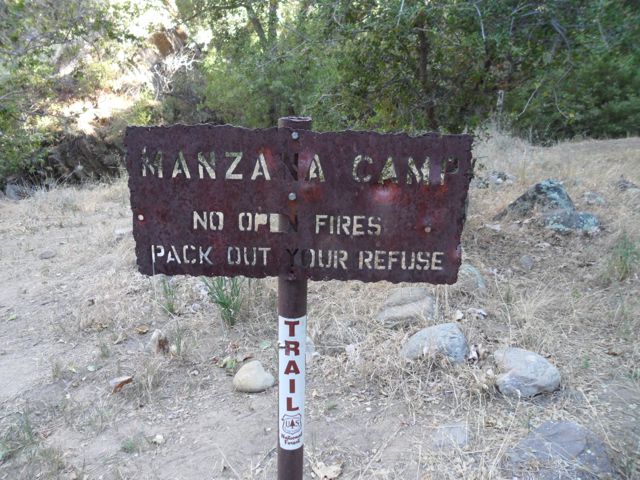
I head on, recross the creek, and push hard for three more miles to the first over-night spot, interesting Manzana Camp, situated right next to the stream with handy pools as well as a functional table for cooking and sitting ([PHOTO 8] described in my “Merry Days along Manzana Creek” column.
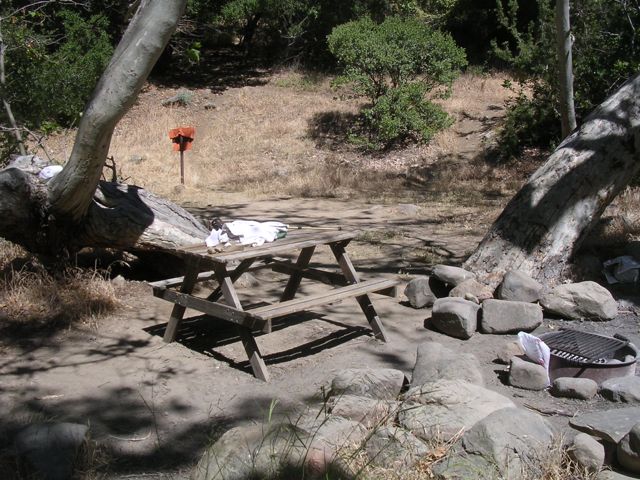
Day Two begins early with a steep ascent winding up the narrow gorge to finish this rugged 1.1 mile backpack portion to over-used Manzana Narrows Camp. I water-up there at the deep pool, and then ascend another very steep 0.9 mile to the second overnight camp. This is a San Raf “free camp” — behind the huge boulder — as you near the Notch. This is a shaded camp, but the fire-pit is weirdly beautiful, and you’re located just below the so-called eastern escarpment of the Hurricane Deck east section (en route to White Ledge Camp).
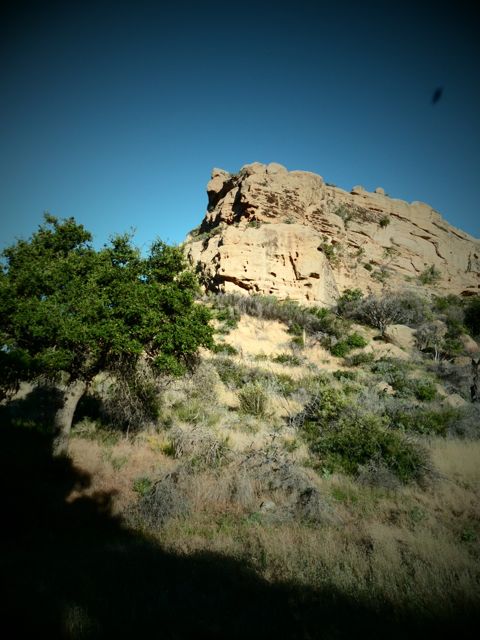
Although a bit tired from just these two miles, all uphill, after a short break and a Clif bar, and tent set-up, I decide to forge ahead and get up onto the upper land. The nunasin cannot follow the desperate urban refugee this far into the mountains, and an easy afternoon dayhike brings me high into the white sandstone table-lands where I can ramble and explore rock shelters in search of elusive pictographs and petroglyphs.
I am unable to determine either the why or the how of Holt’s crucial question, Why is there something rather than nothing? The astounding spectacle in the riparian oak woodland paradise knocks these philosophical inquiries right out of my head. Back here, where we find time for mindfulness, we begin to understand Ludwig Wittgenstein’s answer to the eternal enigma:
“The riddle does not exist.” – Tracatus Logico-Philosophicus proposition 6.5
Carl Jung once plaintively wrote:
“I am still a victim of my thinking. When can I order my thinking to be quiet so that my thoughts, those unruly hounds, will crawl to my feet? … Help me so that I do not choke on my own knowledge. … My knowledge has a thousand voices … and I am their defenseless sacrifice. –The Red Book: Liber Novus.
Jung’s early 20th century Zurich had much less urban madness and machine noise than the early 21st century Santa Barbara—Los Angeles corridor, but aren’t we all choking on data? Ambling beneath the glowering hot hillsides, always within earshot of Manzana river-music, brazenly sleeping outdoors, almost 10 miles from the nearest road, I’m unarmed and feeling especially secure. Perhaps a few demons hover about come evening, thinking of my darling life-partner of four decades – but the piees of gear are lined up, so I’ll just slip into the mesh-topped tent and sleep until morning. The third day cometh.
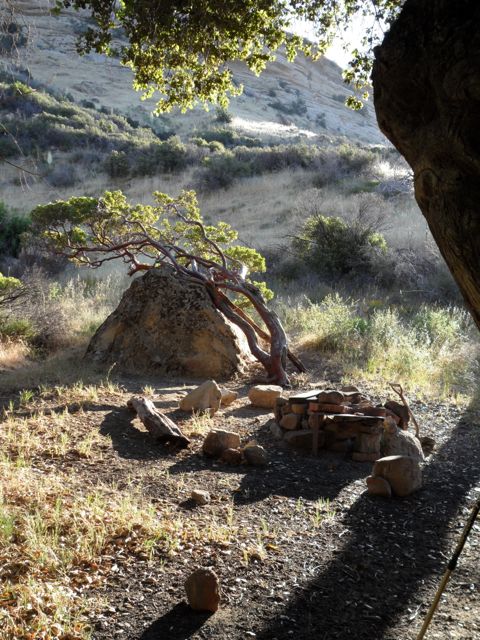
On the third day, The Return, it’s easy to stroll back out to the truck parked at Nira Camp, a pretty steady and mostly descending 9-mile pack. Tonight at home it’ll be hot shower, light yoga asanas, ibuprofen (400 mg), and various ointments for sore leg muscles. All the way, I’ll be absorbing the stress-reducing wilderness, the lilac fragrance of white ceanothus, and swimming in at least one water-hole, likely the one at the Narrows Camp where I filled water bottles yesterday.
Holt writes that there is some sort of order to existence – the Greek term kosmos can mean arrangement (order) as well as adornment (beauty). We are hard-wired to love beauty in the wild as well as to ask metaphysical questions. Storming out into the San Raf is one excellent choice for taking care of both these instinctive urges. Take your own children or grandchildren out there! Immersion in the Santa Barbara backcountry blasts away some of the urban ennui and discouragement.



